wheel CITROEN C-ELYSÉE 2022 Handbook (in English)
[x] Cancel search | Manufacturer: CITROEN, Model Year: 2022, Model line: C-ELYSÉE, Model: CITROEN C-ELYSÉE 2022Pages: 260, PDF Size: 8.4 MB
Page 4 of 260

2
.
.
Instrument Panel 8
W arning and indicator lamps 9
I
ndicators
19
Distance recorders
2
4
Setting the date and time
2
4
Trip computer
2
6Remote control
2
9
Alarm
32
Doors
33
Boot
34
Window controls
3
6
Front seats 3 7
Rear bench seat 3 9
Steering wheel adjustment 4
0
Mirrors
4
0
Heating
4
1
Manual air conditioning
(without display screen)
4
2
Electronic air conditioning
(with display screen)
4
4
Front demist – defrost
4
5
Rear screen demist – defrost
4
6
Fittings
4
8Lighting control
5
1
Direction indicators
5
3
Headlamp adjustment
5
4
Wiper control stalk
5
4
Courtesy lamps
5
5
General safety recommendations
5
7
Hazard warning lamps
5
8
Horn 58
Emergency or assistance call 5 8
Electronic stability control (ESC)
6
0
Seat belts
6
2
Airbags
65
Child seats
6
8
Deactivating the passenger's front airbag
7
0
ISOFIX mountings
7
5
Child lock
7
9
Over view
Instruments Access
Ease of use and comfort Safety
Lighting and visibility
Eco-driving
Eco-driving 6
Contents
Page 5 of 260
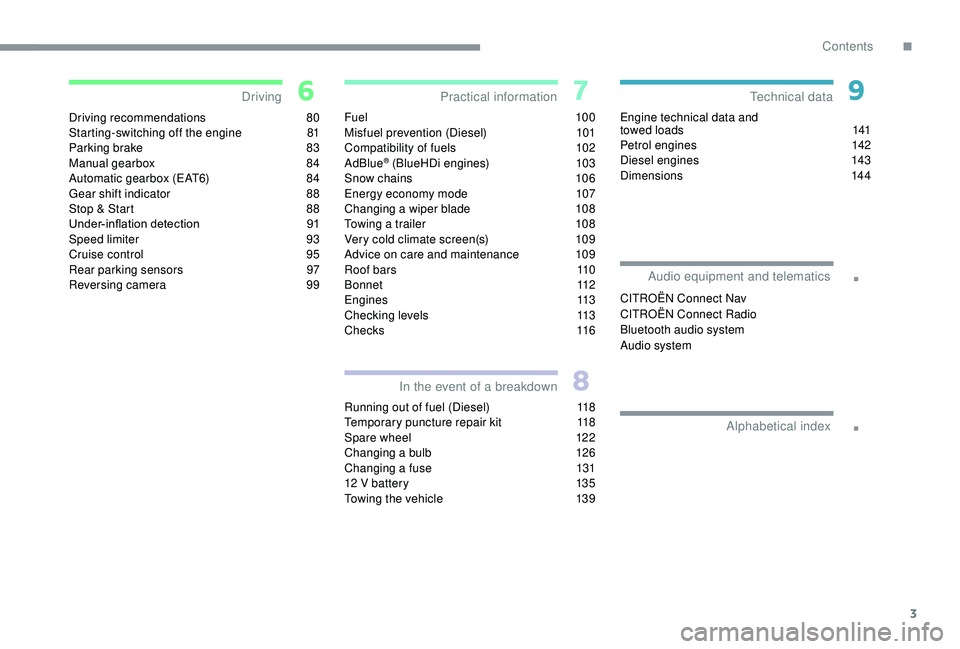
3
.
.
Driving recommendations 80
Starting-switching off the engine 8 1
Parking brake
8
3
Manual gearbox
8
4
Automatic gearbox (EAT6)
8
4
Gear shift indicator
8
8
Stop & Start
8
8
Under-inflation detection
9
1
Speed limiter
9
3
Cruise control
9
5
Rear parking sensors
9
7
Reversing camera
9
9Fuel 1
0 0
Misfuel prevention (Diesel) 1 01
Compatibility of fuels
1
02
AdBlue
® (BlueHDi engines) 1 03
Snow chains 1 06
Energy economy mode
1
07
Changing a wiper blade
1
08
Towing a trailer
1
08
Very cold climate screen(s)
1
09
Advice on care and maintenance
1
09
Roof bars
1
10
B o n n e t
112
Engines
1
13
Checking levels
1
13
C h e c k s
11
6
Running out of fuel (Diesel)
1
18
Temporary puncture repair kit
1
18
Spare wheel
1
22
Changing a bulb
1
26
Changing a fuse
1
31
12
V battery
1
35
Towing the vehicle
1
39Engine technical data and
towed loads
1
41
Petrol engines
1
42
Diesel engines 1 43
Dimensions 144
DrivingPractical information
In the event of a breakdown Technical data
Alphabetical index
Audio equipment and telematics
CITROËN Connect Nav
CITROËN Connect Radio
Bluetooth audio system
Audio system
.
Contents
Page 7 of 260
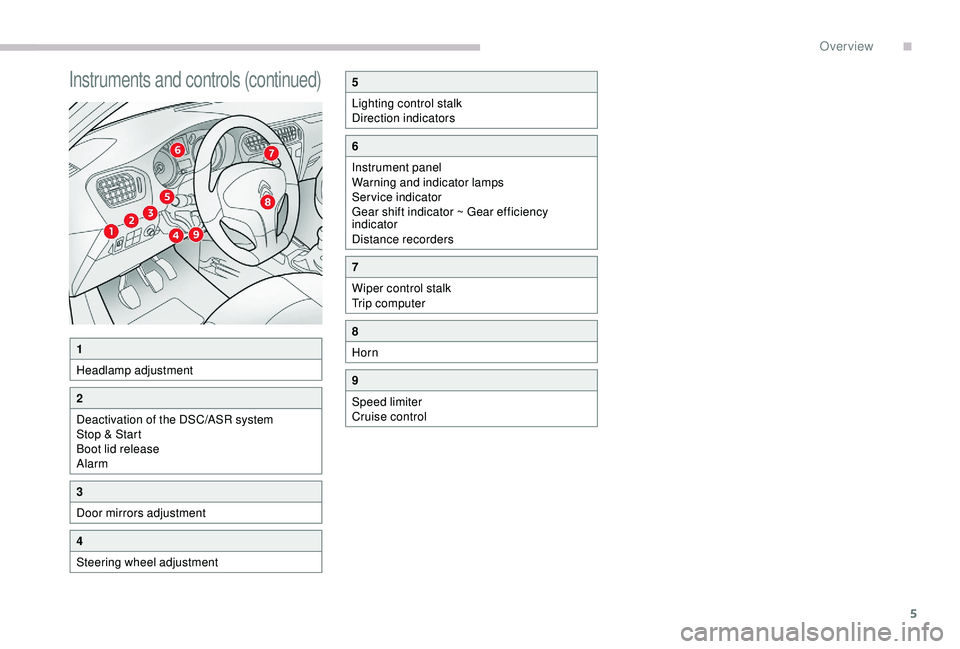
5
Instruments and controls (continued)
1
Headlamp adjustment
2
Deactivation of the DSC/ASR system
Stop & Start
Boot lid release
Alarm
3
Door mirrors adjustment
4
Steering wheel adjustment
5
Lighting control stalk
Direction indicators
6
Instrument panel
Warning and indicator lamps
Service indicator
Gear shift indicator ~ Gear efficiency
indicator
Distance recorders
7
Wiper control stalk
Trip computer
8
Horn
9
Speed limiter
Cruise control
.
Over view
Page 9 of 260
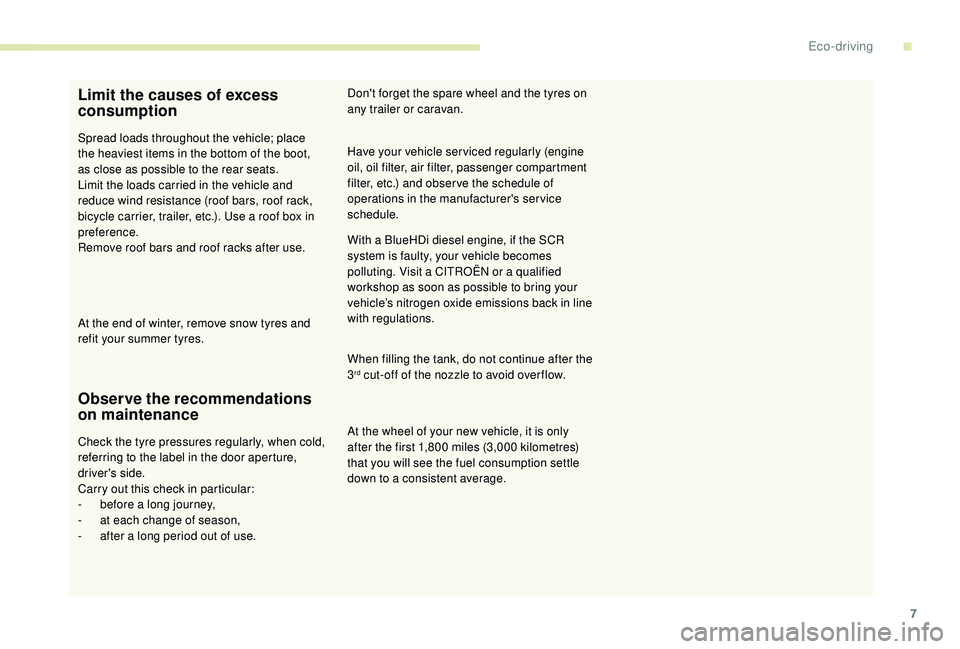
7
Limit the causes of excess
consumption
Spread loads throughout the vehicle; place
the heaviest items in the bottom of the boot,
as close as possible to the rear seats.
Limit the loads carried in the vehicle and
reduce wind resistance (roof bars, roof rack,
bicycle carrier, trailer, etc.). Use a roof box in
preference.
Remove roof bars and roof racks after use.
At the end of winter, remove snow tyres and
refit your summer tyres.
Observe the recommendations
on maintenance
Check the tyre pressures regularly, when cold,
referring to the label in the door aperture,
driver's side.
Carry out this check in particular:
-
b
efore a long journey,
-
a
t each change of season,
-
a
fter a long period out of use. Have your vehicle ser viced regularly (engine
oil, oil filter, air filter, passenger compartment
filter, etc.) and obser ve the schedule of
operations in the manufacturer's service
schedule. Don't forget the spare wheel and the tyres on
any trailer or caravan.
With a BlueHDi diesel engine, if the SCR
system is faulty, your vehicle becomes
polluting. Visit a CITROËN or a qualified
workshop as soon as possible to bring your
vehicle’s nitrogen oxide emissions back in line
with regulations.
When filling the tank, do not continue after the
3
rd cut-off of the nozzle to avoid over flow.
At the wheel of your new vehicle, it is only
after the first 1,800
miles (3,000 kilometres)
that you will see the fuel consumption settle
down to a consistent average.
.
Eco-driving
Page 15 of 260
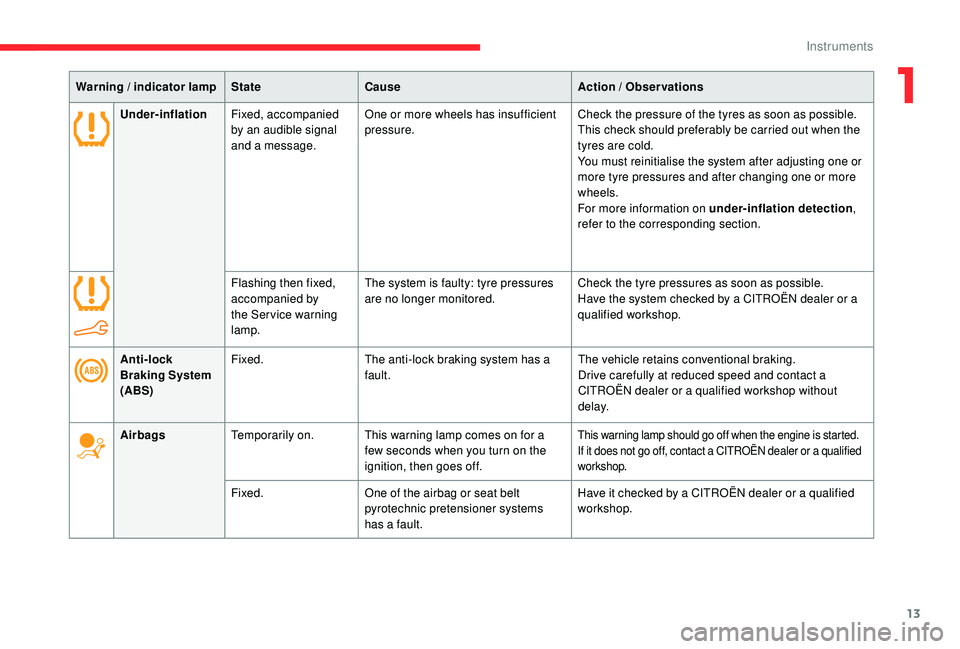
13
Under-inflationFixed, accompanied
by an audible signal
and a message. One or more wheels has insufficient
pressure.
Check the pressure of the tyres as soon as possible.
This check should preferably be carried out when the
tyres are cold.
You must reinitialise the system after adjusting one or
more tyre pressures and after changing one or more
wheels.
For more information on under-inflation detection
,
refer to the corresponding section.
Flashing then fixed,
accompanied by
the Ser vice warning
lamp. The system is faulty: tyre pressures
are no longer monitored.
Check the tyre pressures as soon as possible.
Have the system checked by a CITROËN dealer or a
qualified workshop.
Anti-lock
Braking System
(ABS) Fixed.
The anti-lock braking system has a
fault. The vehicle retains conventional braking.
Drive carefully at reduced speed and contact a
CITROËN dealer or a qualified workshop without
d e l ay.
Airbags Temporarily on. This warning lamp comes on for a
few seconds when you turn on the
ignition, then goes off.
This warning lamp should go off when the engine is started.
If it does not go off, contact a CITROËN dealer or a qualified
workshop.
Fixed.One of the airbag or seat belt
pyrotechnic pretensioner systems
has a fault. Have it checked by a CITROËN dealer or a qualified
workshop.
Warning / indicator lamp
StateCause Action / Observations
1
Instruments
Page 34 of 260
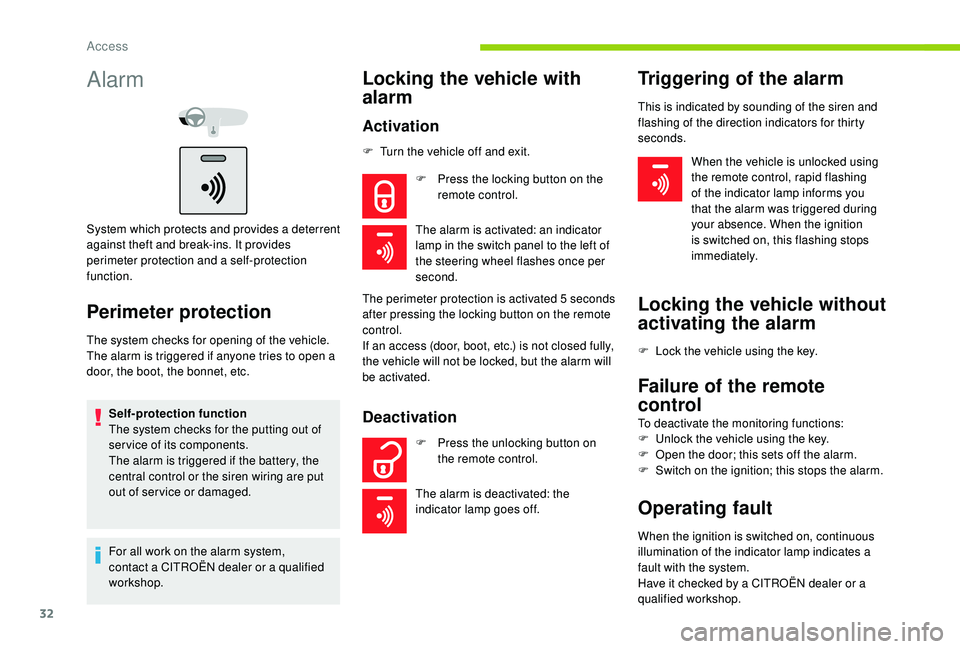
32
Alarm
System which protects and provides a deterrent
against theft and break-ins. It provides
perimeter protection and a self-protection
function.
Perimeter protection
The system checks for opening of the vehicle.
The alarm is triggered if anyone tries to open a
door, the boot, the bonnet, etc.Self-protection function
The system checks for the putting out of
ser vice of its components.
The alarm is triggered if the battery, the
central control or the siren wiring are put
out of ser vice or damaged.
For all work on the alarm system,
contact a CITROËN dealer or a qualified
workshop.
Locking the vehicle with
alarm
Activation
F Press the locking button on the remote control.
The alarm is activated: an indicator
lamp in the switch panel to the left of
the steering wheel flashes once per
second.
Deactivation
F Press the unlocking button on the remote control.
The alarm is deactivated: the
indicator lamp goes off.
Triggering of the alarm
F Turn the vehicle off and exit.
The perimeter protection is activated 5
seconds
after pressing the locking button on the remote
control.
If an access (door, boot, etc.) is not closed fully,
the vehicle will not be locked, but the alarm will
be activated. When the vehicle is unlocked using
the remote control, rapid flashing
of the indicator lamp informs you
that the alarm was triggered during
your absence. When the ignition
is switched on, this flashing stops
immediately.
This is indicated by sounding of the siren and
flashing of the direction indicators for thirty
seconds.
Locking the vehicle without
activating the alarm
F Lock the vehicle using the key.
Failure of the remote
control
To deactivate the monitoring functions:
F
U nlock the vehicle using the key.
F
O
pen the door; this sets off the alarm.
F
S
witch on the ignition; this stops the alarm.
Operating fault
When the ignition is switched on, continuous
illumination of the indicator lamp indicates a
fault with the system.
Have it checked by a CITROËN dealer or a
qualified workshop.
Access
Page 42 of 260

40
Steering wheel adjustment
As a safety precaution, these operations
should only be carried out while the
vehicle is stationary.
Mirrors
Door mirrors
Demisting – Defrosting
Demisting-defrosting of the door
mirrors operates with the engine
running, by switching on the heated
rear screen.
For more information on Demisting and
defrosting the rear screen , refer to the
corresponding section.
Manual model
Adjustment
Folding
F Fold the mirror manually to protect it when the vehicle is parked.
Unfolding
F Unfold it before moving off again.
F
W
hen stationary
, lower the control stalk to
release the steering wheel.
F
A
djust the height to suit your driving
position.
F
P
ull the control stalk to lock the steering
wheel adjustment mechanism. Each fitted with an adjustable mirror glass
allowing for the lateral rear vision necessary for
overtaking or parking. They can also be folded
for parking in confined spaces.
As a safety measure, the mirrors should
be adjusted to reduce the blind spots.
The objects obser ved are, in reality, closer
than they appear.
Take this into account in order to
correctly judge the distance of vehicles
approaching from behind. F
O
perate the lever in the four directions to
adjust the angle of the mirror glass.
Ease of use and comfort
Page 43 of 260

41
Electric model
Adjustment
F Move the control A to the right or to the left to select the corresponding mirror.
F
M
ove the control in all four directions to
adjust.
F
R
eturn the control to the central position.
Manual folding
You can manually fold the mirrors (parking
obstruction, narrow garage, etc.)
F
T
urn the mirror towards the vehicle.
Rear view mirror
Equipped with an anti-dazzle system, which
darkens the mirror glass and reduces the
nuisance to the driver caused by the sun,
headlamps of other vehicles, etc.
Adjustment
F Adjust the mirror so that the mirror is directed correctly in the "day" position.
Day / night position
F Pull the lever to change to the "night" anti-dazzle position.
F
P
ush the lever to change to the normal
"day" position.
Heating / Ventilation
This system operates only with the engine
running.
1 Temperature.
2 A ir f low.
3 Air distribution.
4 Air intake / Air recirculation.
Temperature
F Turn the thumb wheel from
blue (cold) to red (hot) to adjust
the temperature to your liking.
Air flow
F Turn the thumb wheel to obtain a comfortable air flow.
3
Ease of use and comfort
Page 44 of 260

42
Deactivation
If you put the air flow control in the 0 position,
t he temperature is no longer controlled.
A slight flow of air can still be felt, resulting from
the for ward movement of the vehicle.
Air distribution
Windscreen and side windows.
Windscreen, side windows and
footwells.
Footwells.
Centre and side air vents,
footwells.
Central and side vents.
The air distribution can be adapted
by placing the thumb wheel in an
intermediate position or by closing
the vents.
Air intake / Air recirculation
Recirculation of the interior air isolates the
passenger compartment from exterior odours
and fumes.
Return to exterior air intake as soon as possible
to avoid deterioration of the air quality and the
formation of mist.
F
M
ove the manual control to the
left for the "Recirculation of
interior air" position.
F
M
ove the manual control to the
right to return to the "Exterior air
intake" position.
Manual air conditioning
(without display screen)
This system operates only with the engine
running.
1 Temperature.
2 A ir f low.
3 Air distribution.
4 Air intake / Air recirculation.
5 Air conditioning.
Temperature
F Turn the thumb wheel from
blue (cold) to red (hot) to adjust
the temperature to your liking.
Air flow
F Turn the thumb wheel to obtain a comfortable air flow.
Ease of use and comfort
Page 45 of 260

43
Deactivation
If you put the air flow control in the 0 position,
t he temperature is no longer controlled.
A slight flow of air can still be felt, resulting from
the for ward movement of the vehicle.
Air distribution
Windscreen and side windows.
Windscreen, side windows and
footwells.
Footwells.
Centre and side air vents,
footwells.
Central and side vents.
The air distribution can be adapted
by placing the thumb wheel in an
intermediate position or by closing
the vents.
Air intake / Air recirculation
Recirculation of the interior air isolates the
passenger compartment from exterior odours
and fumes.
Return to exterior air intake as soon as possible
to avoid deterioration of the air quality and the
formation of mist.
F
M
ove the manual control to the
left for the "Recirculation of
interior air" position.
F
M
ove the manual control to the
right to return to the "Exterior air
intake" position.
Air conditioning
The air conditioning is designed to operate
efficiently in all seasons, with the windows
closed.
It allows you:
-
i
n summer, to lower the temperature,
-
i
n winter, to increase the effectiveness of
the demisting, above 3°C.
Switching on
F Press this button, its indicator lamp comes on.
The air conditioning does not operate
when the air flow adjustment control is in
position "0".
Faster cool air
To obtain cool air more quickly, you can
use recirculation of the interior air for a few
moments. F
M
ove the manual control to the
left for the "Recirculation of
interior air" position.
F
T
hen, move the manual control
to the right to return to the
"Exterior air intake" position.
Switching off
F Press this button again, its indicator lamp goes off.
Switching the system off could result in
discomfort (humidity, condensation).
3
Ease of use and comfort